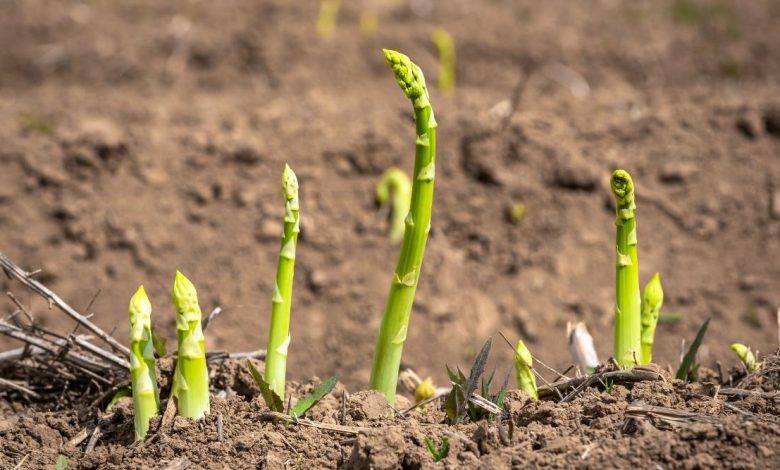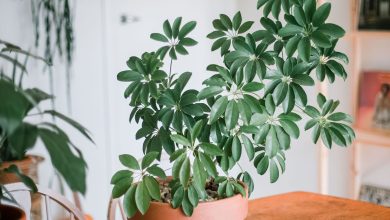Plant Asparagus: [Care, Needs, Irrigation, Fertilizer and More]

Did you know?
I love asparagus. And if you’re here, I sense that you are too.
Why don’t you plant them in your garden? Without pesticides, or chemicals?Completely ecological?
The only thing I ask of you is 5 minutes of your attention and that you then put it into practice.
I assure you it’s worth it. Then they are delicious. Important Points when Planting Asparagus:
- When? Early Spring.
- Where? Sun exposure area. At least 5 hours a day.
- Harvest time? Two or three years from initial planting.
- How do we prepare the land? Stirred, aerated, drained. With sand if possible. With a pH between 6.5-7.

- How do we pay? They are not very demanding. Some compost and organic animal matter.
- How do we water? Ideal, with drip.
- How often do we water? First phase, every 2-3 days, keep moist. As the plant grows, we will reduce the irrigation frequency to 1-2 weekly irrigations (depending on the heat).
- How do we sow? Through seeds, holes 10cm deep leaving half a meter of space between each one.
- How do we harvest? When the stems reach 15cm in height, cut the stems from time to time using a sharp knife or scissors.
- Good associations? Lettuce, parsley, broad beans, peas, beans, tomato, basil, coriander and calendula.
- Bad associations? Garlic, onion or potatoes.
- Plagues and diseases? Asparagus beetle, asparagus fly, rust, rhizoctonia, fusiarosis, and gray mold.
Asparagus are the young shoots of the asparagus tree, a herbaceous plant that reaches up to a meter and a half in height and is related to onions and leeks.
The cultivation of asparagus has been very widespread in the Mediterranean or in similar climates because it is ideal for its correct growth.
You have to keep in mind that planting asparagus is not complicated, however it requires patience.
They are excellent allies against kidney disorders and, due to their antioxidant properties, they are widely recommended to prevent degenerative diseases and cancer.
Thanks to its controlled cultivation in greenhouses, we can find asparagus on the market throughout the year, although its best harvest time is during the first two months of spring.
On the other hand, the production of canned asparagus is in great demand in many countries, it is not unusual to buy them in convenience stores or supermarkets.
Of course,the best alternativeis that it is to sow asparagus oneself.
If you are interested in it, in this article we tell you the most effective way to achieve success when planting your own asparagus.
Did you know…Hippocrates recommended drinking dried asparagus tea for diuretic purposes, and its root served as a remedy against toothaches and bee stings.
Conditions for Planting Asparagus
To sow asparagus effectively, we must take into account the following requirements in our crop:
The weather
 They are warm – season vegetables, so they need partial or full sun, although they are capable of adapting to all climates.
They are warm – season vegetables, so they need partial or full sun, although they are capable of adapting to all climates.
Paradoxically, and despite the above, asparagus grows best in areas that have very cold winters, during which the ground freezes; therefore, it is highly recommended to find out if asparagus production is viable in the region in which you live.
Even taking into account its adaptability, its development can be affected if temperatures exceed 30 °C. Likewise, below 15 ºC during the day or 10 ºC at night, its development stops.
vThus, the ideal temperature ranges from 18 °C to 25 °C during the growth stage.
It is also recommended to plant in places where the wind is not a problem.
The lighting
As far as light is concerned, asparagus can be grown in sunny or partial shade as long as it has adequate light.
As it is green asparagus, the color characteristic is a quality factor, therefore efforts should be made to capture the greatest amount of light, so that the chlorophyll necessary to achieve said color can be synthesized and to carry out photosynthesis correctly.
You can choose a place near trees that have not yet sprouted leaves.
Irrigation
 Irrigation should be carried out according to the state in which the crop is found. Asparagus are not particularly fussy about water.
Irrigation should be carried out according to the state in which the crop is found. Asparagus are not particularly fussy about water.
Newly planted, it is necessary to maintain the humidity for a few weeks. When the asparagus is developing the shoots you have to be generous with the watering, but without flooding.
During the rest of the cycle, it is irrigated by decreasing the amount of water.
The best way to irrigate them is by dripping, as they are sensitive to waterlogging, which can cause root suffocation.
The optimum relative humidity in the growth of shoots is between 60 and 70%.
Regular watering is best for shoot development, especially during the first year of cultivation. The soil must remain moist to the touch at all times.
In the first phase of growth it is only necessary to water once a week, in order to maintain humidity.
Afterwards, it will only be watered when it has been a long time without rain, approximately once a week but using less water than in the first phase.
Did you know…Oceana County, Michigan has declared itself the asparagus capital of the world.
Throughout the crop, there are three important moments in terms of irrigation: the first takes place in the plantation, this is unique and only takes place the first year of cultivation.
The objective of this irrigation is to maintain the humidity of the root system and help the formation of the claw.
The other two irrigations correspond to the harvest and the annual development of the aerial part, being annual and variable according to the state of the crop.
Harvest irrigation aims to maintain moisture in the area where the shoots will emerge. In general, these risks will be light, ensuring that the soil is not waterlogged.
The development irrigation of the aerial part influences both the nutrients and the water for the good development of the aerial part. Drip irrigation is recommended at this stage to prevent the development of fungi.
1 or 2 weekly irrigations will be applied,depending on environmental conditions.
If a drip system is not available, during harvest time it is recommended to irrigate by sprinkling; if it is with micro-sprinklers better.
On the other hand, during the period of vegetative development, it must be irrigated using the traditional gravity system.
Did you know…Not all people are able to perceive the characteristic smell of asparagus in urine.
the substrate
 Asparagus cultivation should be done in well-drained soils, without stones or other debris, light, moderately fertile and rich in organic matter.
Asparagus cultivation should be done in well-drained soils, without stones or other debris, light, moderately fertile and rich in organic matter.
Highly compacted soils should be avoided.
The optimal pH is between 7.5 and 8, although it also admits soils with a pH of 6.5.
Prepare a preferably sandy soil, with good depth, soft and with a good contribution of organic matter.
Asparagus are not very demanding in terms of nutrients and fertilizing once a year with compost or earthworm humus is enough.
It must be kept free of clods and pieces of earth because these make it difficult for the shoots to develop.
Before planting the asparagus
the seeds
If you want to grow this plant, the first thing you should do is obtain quality asparagus seeds. You can do this in a nearby nursery where you live or directly buying on Amazon.
The seeds are dark brown or black, round in shape. As a particularity, the asparagus seed has a high germination power.
pH
 Optimum pH values range between 7.5 and 8.
Optimum pH values range between 7.5 and 8.
The fertilizer
Before planting the asparagus, apply homemade organic matter such as compost or earthworm humus to the soil.
Where to grow asparagus?
Preferably outdoors. With direct sun preferably.
A well-drained, deep, sandy loam soil is recommended.
Preferably without very intense drafts.
land preparation
The preparation of the land when planting asparagus is essential.
The land must have a good filter. Also, it should be loose enough, without being compressed.
The Planting of the Asparagus
On what dates?
Aearly spring.
Therefore, in Spain we will take into account the months of March, April and May. In Latin America we will focus on the months of October and November.
The planting process
 Introduce the seeds in holes of 10 cms. deep and leave approximately half a meter of space between each plant.
Introduce the seeds in holes of 10 cms. deep and leave approximately half a meter of space between each plant.
If you plant seedlings, these can be planted in mounds to improve soil drainage.
The seeds can also be planted in seedbeds, seedbeds or modules during the spring, to later be transplanted to the place where they will grow at the beginning of the summer.
Cover the seeds with a few millimeters of soil on top and water until the soil is very moist.
The Slouch
Asparagus plants are monoecious, meaning each plant is either male or female.
The female plants are dedicated to producing seeds, so they do not produce as many stems as the males.
When the plants begin to produce flowers, you will be able to tell which are male and which are female. Male plants will have large, long flowers, and female plants will have smaller flowers.
Remove the female plants and use them to make compost.
The Harvest and Collection of the asparagus
 The asparagus plant can produce shoots for ten years, depending on how they are treated.
The asparagus plant can produce shoots for ten years, depending on how they are treated.
If you sow asparagus by seed, they can be obtained from the third year. You can pick them in both spring and fall.
Cut the stems from time to time using a sharp knife or scissors.
As your plants produce more stems, you will need to harvest them more often.
The stems will be ready to harvestwhen they reach 15 centimeters in heightand the tips begin to loosen.
Limit the first harvest to 3 weeks, cutting stems every few days, and being careful not to remove too many from the same plant. The following year, extend your harvest time to 5 weeks.
The following years, you can extend it to 6 weeks.
the post harvest
Once the shoots have been collected, they must be placed in a vertical position to prevent the upper end from bending. It is recommended that the base end be kept submerged in water.
Cold storage is done at 2 ºC and 95% relative humidity; Keep in mind that asparagus quickly loses its properties.
Favorable Associations
El espárrago funciona muy bien en asociación con la lechuga y el perejil.
Cuando se siembra con habas, guisantes o judías, la estructura de la tierra mejora, ya que estas plantas, cuando están juntas, se hacen crecer más fuertes y sanas e incluso puede aumentar un poco la cosecha.
Otras mezclas a tener en cuenta son: tomate, albahaca, perejil, cilantro y caléndula.
Asociaciones Desfavorables
No es recomendable en asociación con el ajo, la cebolla o las patatas.
En cuanto a la rotación de cultivos, se ha de evitar cultivar espárrago dónde anteriormente ha habido zanahoria, remolacha, alfalfa o patatas.
Plagas y Enfermedades comunes
Escarabajo del espárrago
Para combatirlo se recomienda el uso de aceite de Neem y jabón potásico.
Mosca del espárrago
El tratamiento con insecticida no es muy efectivo ya que las larvas se esconden en el interior de la planta. Al igual que con el escarabajo, se recomienda el uso de aceite de Neem y jabón potásico.
Roya
Es un hongo que produce manchas rojas/naranjas.
Rizhoctonia
Otro tipo de hongo que produce espárragos cortos, duros y delgados.
Fusiarosis
Es un hongo que ataca a las raíces y mata a la planta.
En los tres casos anteriores
Se puede usar trichoderma: un hongo antagonista capaz de hacerles frente y prevenir el ataque de estos organismos.
También se puede hacer usos de caballo/»>cola de caballo.
Moho gris (botritis)
Se produce por humedad y mala ventilación.
Principales características y tipos de espárragos
 Propiamente, lo que se consume de la esparraguera son los turiones, nombre que se le da a los brotes que sobresalen de las plantas subterráneas.
Propiamente, lo que se consume de la esparraguera son los turiones, nombre que se le da a los brotes que sobresalen de las plantas subterráneas.
En ese sentido, la planta de espárrago está conformada por una parte subterránea, conocida comúnmente como garra. Su floración se produce a partir de junio.
Las flores son pequeñas y campanuladas, y se distribuyen en parejas o en solitario.
Y aunque la palabra espárrago, en su uso más extendido, sirve para identificar a esta herbácea, específicamente la Asparagus officinalis, cabe decir que muchas plantas, pueden ser llamadas «espárragos» cuando se comen sus brotes.
Esto, con base en la etimología latina de la palabra, sparagus, que a su vez deriva del griego aspharagos que significa «brote».
The origin of asparagus is located near the Tigris and Euphrates rivers, but there is also evidence of its consumption in hieroglyphs found in Egypt.
Likewise, in ancient Greece it was a highly appreciated herb and its cultivation became popular in Europe due to Roman influence.
Currently, the main asparagus producing countries are China (with approximately 84% of world production), Peru, with a continuously increasing production, thanks to its climatic conditions that allow it to produce throughout the year, and the United States with a participation of only 2%.
There are three main varieties,white, green and purple asparagus.
Did you know…Emperor Caesar Augustus used to say: «Velocius quam asparagi conquantur!» What he means: «Faster than cooking asparagus»
white asparagus
Its lack of color is due to the fact that it grows underground and, as it does not receive sunlight, it does not develop chlorophyll.
The Argentevil asparagus (thick and firm) and the Darbonne asparagus (very thick and highly productive) stand out.
Green asparagus
Also known as black, bitter or triguero asparagus. It grows in contact with sunlight.
Some of the best known varieties of green asparagus are the Huetor asparagus (a variety from the Granada town of Huetor-Tájar).
The Plaverd asparagus (less early than the previous one), the North American UC-157, (which is one of the earliest and most productive varieties on the market), and the green California asparagus, among others.
purple asparagus
It is mainly characterized by a high sugar content and low fiber levels.
It was originally cultivated in Italy and marketed under the name Violetto d’Albenga. Its cultivation continued in European countries and jumped to America, Asia and New Zealand.
Depending on their caliber, asparagus is also classified as:
- Extra thick asparagus: between 14 and 19 millimeters thick.
- Thick Asparagus: 11 to 14 millimeters thick.
- Medium Asparagus: between 9 and 11 millimeters thick.
- Thin Asparagus: its caliber is less than 9 millimeters.
Did you know…Sea salt is a natural herbicide for asparagus when it is still in cultivation.
To learn more, read: Varieties of asparagus.
Main benefits and properties of asparagus
One cup of asparagus contains approximately 27 calories, 2 grams of fat, 5 grams of carbohydrates, 3 grams of sugar, 3 grams of fiber, and 3 grams of protein.
As if this were not enough, its high nutrient content means that asparagus is considered one of the most beneficial foods for human consumption.
Among its many properties, we can highlight the following:
- They are diuretics: Asparagus are made up of a large amount of water and contain asparagus, which stimulates urination. This is beneficial for the treatment of hypertension, fluid retention, bladder diseases, diabetes and many other diseases.
- The oxalates in asparagus help dissolve kidney stones.
- Due to its high content of folic acid, it reduces the risk of suffering from congenital anomalies. This, in addition, in combination with iron is ideal to counteract anemia.
- Prevents osteoporosis. A cup of asparagus provides 70% of the vitamin K needed per day. Vitamin K promotes calcium absorption and improves bone health.
- Asparagus have a high fiber content, ideal for improving intestinal transit and fighting constipation.
- In addition, they are very rich in protein, which contributes to the construction of the tissues that make up the muscles.
- They are antidepressants. Due to its contribution of minerals and folic acid, asparagus helps fight depression and fatigue. They regulate brain activity, stimulate nerve impulses and help prevent degenerative diseases.
- They help fight insomnia.
- Its high supply of vitamins contributes to cellular oxygenation, the formation of red blood cells, the strengthening of the immune system, the fight against infections and many other benefits.
- Asparagus contains zinc, which increases sexual potency and fertility. Also, they are aphrodisiacs.
- Raw, they are very effective for the treatment of baldness and alopecia.
- They have anti-inflammatory properties.
- They can be used to calm coughs, bronchial problems and, in general, to help normalize respiratory functions.
Conclusion and Recommendations
Consider waiting an extra year before harvesting asparagus, or only harvesting a portion of the vegetable during your first year of harvest.
The more time you give asparagus plants to establish themselves, the longer they will live and the more bountiful your subsequent harvests will be.
Bibliography and references
-
Yield of green and white asparagus under two harvesting modalities, H Krarup, KL Aage, P June – 37. Congreso Agronomico, Santiago, 7-10 …, 1986 – sidalc.net



![Photo of How to Plant Nasturtium in your Garden: [Complete Guide and Steps to Follow]](https://www.complete-gardening.com/wp-content/uploads/2022/08/how-to-plant-nasturtium-in-your-garden-complete-guide-and-steps-to-follow-390x220.jpg)
![Photo of [7] Varieties of Potatoes and their Characteristics](https://www.complete-gardening.com/wp-content/uploads/2022/08/7-varieties-of-potatoes-and-their-characteristics-390x220.jpg)